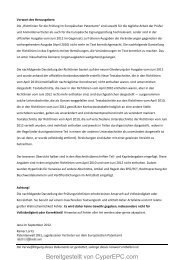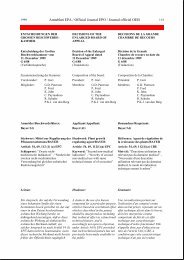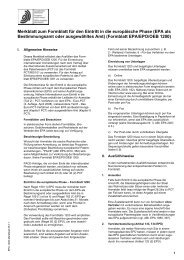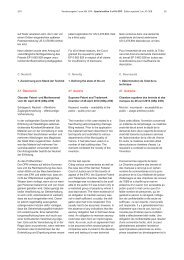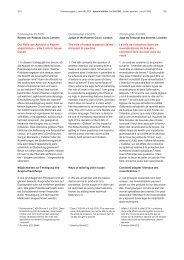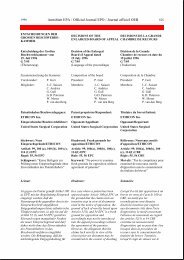Sonderausgabe 3 zum ABl. EPA 2011/107 - CyberEPC
Sonderausgabe 3 zum ABl. EPA 2011/107 - CyberEPC
Sonderausgabe 3 zum ABl. EPA 2011/107 - CyberEPC
You also want an ePaper? Increase the reach of your titles
YUMPU automatically turns print PDFs into web optimized ePapers that Google loves.
112 <strong>Sonderausgabe</strong> 3 <strong>zum</strong> <strong>ABl</strong>. <strong>EPA</strong> Special edition 3 of OJ EPO Edition spéciale 3 du JO OEB <strong>2011</strong>Der Fachmann (im vorliegenden Fallein ausgebildeter Nachrichtentechnikerund/oder Informatiker mit mehrjährigerBerufserfahrung auf dem Gebiet derTelekommunikation), der es sich zurAufgabe gestellt hatte, eine möglichsteinfache und preiswerte Lösung für dieVerarbeitung von im Voraus bezahltenTelefonanrufen zu finden, kannte zweiArten der Speicherung der zur Durchführungvorbezahlter Telefonanrufe erforderlichenDaten: <strong>zum</strong> einen die Variante, beider die Daten sämtlich auf einem auf derKarte befindlichen Chip oder Magnetstreifengespeichert sind, und <strong>zum</strong> anderendie Variante, dass die Daten in einerDatenbank in der Weise gespeichertsind, dass ein bestimmtes Guthabeneiner bestimmten Identifikationsnummerzugeordnet ist.Wollte der Fachmann den Nachteil vermeiden,dass der Vertrieb Datenleitungenvon der Vertriebsstelle zur Datenbankerforderlich machte, konnte erhierauf nur verzichten, wenn er demKunden die Identifikationsnummer aufandere Weise bekannt gab. Das Gerichtsah jedoch keine Anhaltspunkte dafür,dass dies dem Fachmann die insbesonderebei Chipkarten übliche Standardisierungauf bestimmte Beträge nahelegte,die es ihm dann ermöglichte, dieIdentifikationsnummer schon vor demErwerb des Guthabens durch den Kundendiesem Guthaben zuzuordnen.Dieser Schritt brachte nur dann eineVereinfachung des Vertriebs mit sich,wenn der Fachmann zugleich eineLösung für das Problem erkannte, wiedie Identifikationsnummer dem Kundenbekannt gegeben werden konnte. Hierfürgab es bei der Chipkarte kein Vorbild,weil sich dieses Problem dort nicht stellt.Es genügte also nicht der Übergang vonindividuell bestimmten Guthaben auf vonvornherein standardisierte Guthabenbeträge,vielmehr erforderte dieser Übergangweitere Schritte, nämlich die vorherigeZuordnung von Guthaben undIdentifikationsnummer in der Datenbankund die Bekanntgabe dieser Nummer anden Kunden.The skilled person (in this case, a trainedtelecommunications and/or IT technicianwith several years' professional experiencein the telecommunications sector)approaching the problem of finding thesimplest and cheapest solution possiblefor processing prepaid calls knew of twoways of storing the data needed to makesuch calls: one whereby all the data wasstored in a chip or magnetic strip on thecard and another whereby it was storedin a database, with particular credit beingallocated to a particular ID number.If the skilled person had wished to avoidthe drawback of distribution requiring thetransmission of data from the salespoints to the database, he could onlyhave dispensed with this if he hadprovided the customer with the IDnumber in another way. The Court,however, could find no evidence that thiswould have made it obvious to the skilledperson to adopt the solution of standardisingcertain sums, as was usual in thecase of chip cards in particular, whichwould then have enabled him to allocatethe ID number to credit even before thecustomer had bought that credit. Thisstep would only simplify distribution if, atthe same time, the skilled person identifieda solution to the problem of how toinform customers of their ID number. Thechip-card system could not serve as anexample as the problem did not arisethere. Accordingly, it was not enough tomove from individually set credit tostandard credit amounts fixed from theoutset; rather such a move requiredfurther steps, i.e. the advance allocationof credit and ID number in the databaseand issue of the ID number to thecustomer.L'homme du métier (en l'espèce, untechnicien qualifié en communicationset/ou un informaticien ayant plusieursannées d'expérience dans le domainedes télécommunications), qui se fixaitpour but de trouver une solution la plussimple et la plus économique possiblepour traiter les appels téléphoniquesprépayés, connaissait deux modes demémorisation des données nécessairesà l'exécution de ces appels : soit lavariante dans laquelle toutes lesdonnées sont mémorisées dans la puceélectronique ou la bande magnétique dela carte, soit la variante dans laquelleelles sont stockées dans une banquede données de telle sorte qu'un créditdéterminé est associé à un certainnuméro d'identification.Si l'homme du métier voulait éviterl'inconvénient que la commercialisationnécessitait d'avoir des câbles de transfertdes données entre le service desventes et la banque de données, cen'était possible que si le numéro d'identificationétait communiqué au clientd'une autre manière. La Cour ne voitcependant pas de raison de penserque cela rendait la standardisation desmontants de crédit, usuelle notammentavec les cartes à puce, évidente pourl'homme du métier, standardisation quilui aurait alors permis d'associer àchaque crédit le numéro d'identificationavant que le client n'acquière ce crédit.Cette étape ne pouvait entraîner desimplification au niveau de la commercialisationque si l'homme du métiertrouvait en même temps une solutionau problème de la communication dunuméro d'identification au client. Il n'existaitpas de modèle pour les cartes àpuce, étant donné que ce problème nese pose pas pour elles. Il ne suffisaitdonc pas de passer des crédits déterminésindividuellement aux montants decrédit standardisés d'emblée ; cettedémarche nécessitait au contraire defranchir d'autres étapes, à savoir l'associationpréalable du crédit à un numérod'identification dans la banque dedonnée et la communication de cenuméro au client.



